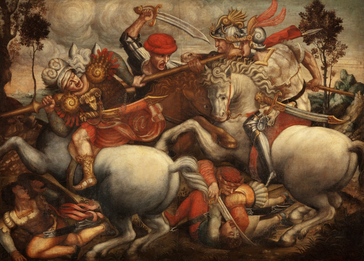“According to the four “expert” authors of a book full of presumptive deductions, Leonardo da Vinci would never have painted the Battle of Anghiari on the Hall of the Five Hundred walls in Palazzo Vecchio, in Florence, thus debunking a so-called myth created by the novellist Dan Brown. This thesis is as random as it is detrimental, and is based on very weak arguments.
Aside the fact that Leonardo’s reputation comes from many other sources than the ones related to his decoration or not of Palazzo Vecchio walls, we have various written testimonies by biographers of the time about the existence of the painting.
Firstly, Paolo Giovio saw the remains of the painting on the Palazzo Vecchio walls and left a vivid description of it in his biography of Leonardo’s life, written between 1523 and 1527:
“In the Florentine Seigniory Council Hall remains a battle and victory over the Pisans, magnificent but unfortunately unfinished due to a defect in the plaster that rejected with singular persistence the colors dissolved in walnut oil. But the disappointment for the unexpected damage seems to have extraordinarily increased the charm of the unfinished work”.
A second testimony is from Anonimo Gaddiano, the anonymous author of the Magliabechiano (a 1540 circa manuscript preserved in original at the National Library of Florence), clearly referring to the painting in the Council Grand Hall:
“He was trying to paint in the Council Grand Hall of the Florentine palace the scene of the Florentine war, when they defeated, in Anghiari, Niccholo Picci(ni)no, captain of Duke Filippo of Milan; he there started to work on it, as today can still be seen, and with paint”.
“… as today can still be seen” says Gaddiano.
Thirdly, Vasari writes about it, in the first edition of The Lives in 1550 published by Torrentini, the one free from censorship imposed in 1568 by Pius V and Cosimo I:
“And envisaging to use oil to color on the wall, he made a composition of a mixture so thick, to stick on the wall, that continuing to paint in that room, it began to pour, so that in a short time he abandoned it.”
A final testimony comes from Anton Francesco Doni in 17 August 1559, who, in a letter addressed to Alberto Lollio, recommending a visit to Palazzo Vecchio from Venice:
“ … give a view to a group of horses, and men (a piece of battle of Lionardo da Vinci) that will seem to you a miraculous thing”.
Regarding the lack of materials (Leonardo “would have never received the materials to make the work”) which is used as justification by the four “experts”, I would like to come back to the statue of Leonardo erected by the city on the Baptistery. The statue was by Giovan Francesco Rustici, a sculptor from the school of the Garden of San Marco who worked in very close contact with Leonardo, hosting him in his home on his return from Milan.
These statues, in the execution of which Leonardo intervened directly, were cast with bronze personally bought by Rustici pawning his house. The materials for the painting at the Hall of the Five Hundred by Leonardo, of whose direct testimony I believe there is no doubt, could have then been purchased by some of his collaborators.”
Riccardo Magnani – This is not Leonardo da Vinci

